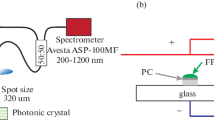Abstract
The control of the spontaneous emission (SE) rate of dye molecules (4-dicyanomethylene-2-methyl-6-p-dimethylaminostyryl-4H-pyran (DCM) and Coumarin 523 (C523)) embedded in the Porous Silicon (PS) matrix has been studied using picosecond resolved fluorescence decay and polarization studies. We have shown that the SE rates of the two organic dyes embedded in the PS matrix depend on the relative positions of the emission maxima of the dyes with respect to electronic band gap energy of the PS matrix. We have also explored that the electronic band gap of the host PS matrix can easily be tuned by partial oxidation of the PS and the nature of SE of the embedded dyes can be tuned accordingly. The demonstrated retardation or enhancement of the spontaneous photon emission may enable the application of fluorescent organic molecules in PS matrix in several quantum optical devices including the realization of single photon sources.







Similar content being viewed by others
References
Bruchez M, Moronne M, Gin P, Weiss S, Alivisatos AP (1998) Semiconductor nanocrystals as fluorescent biological labels. Science 281:2013–2016
Brus LE (1984) Electron–electron and electron-hole interactions in small semiconductor crystallites: the size dependence of the lowest excited electronic state. J Chem Phys 80:4403–4409
Lodahl P, Driel AFV, Nikolaev IS, Irman A, Overgaag K, Vanmaekelbergh D, Vos WL (2004) Controlling the dynamics of spontaneous emission from quantum dots by photonic crystals. Nature 430:654–657
Noda S, Fujita M, Asano T (2007) Spontaneous-emission control by photonic crystals and nanocavities. Nature Photonics 1:449–458
Schubert EF, Kim JK (2005) Solid state light sources getting smart. Science 308:1274–1278
Ziemelis K (1999) Display technology: glowing devolopments. Nature 399:408–411
Gratzel M (2001) Photoelectrochemical cell. Nature 414:338–344
Englund D, Fattal D, Waks E, Solomon G, Zhang B, Nakaoka T, Arakawa Y, Yamamoto Y, Vuckovic J (2005) Controling the spontenious emission rete of single quantum dots in a two-dimentional photonic crystal. Phys Rev Lett 95:013901–013904
Adibi A, Xu Y, Lee RK, Loncar M, Yariv A, Scherer A (2001) Role of distributed Bragg reflection in photonic-crystal optical waveguides. Phys Rev B 64:041101–041104
Povinelli ML, Loncar M, Ibanescu M, Smythe EJ, Johnson SG, Capasso F, Joannopoulos JD (2005) Evanescent-wave bonding between optical waveguides. Opt Lett 30:3042–3044
Anglin EJ, Schwartz MP, Ng VP, Perelman LA, Sailor MJ (2004) Engineering the chemistry and nanostructure of porous silicon Fabry-Pérot films for loading and release of a steroid. Langmuir 20:11264–11269
Chouket A, Elhouichet H, Oueslati M, Koyama H, Gelloz B, Koshida N (2007) Energy transfer in porous-silicon/laser-dye composite evidenced by polarization memory of photoluminescence. Appl Phys Lett 91:211902–211903
Zheng WH, Reece P, Sun BQ, Gal M (2004) Broadband laser mirrors made from porous silicon. Appl Phys Lett 84:3519–3521
Wolkin MV, Jorne J, Faucher PM (1999) Electronic and luminescence in porous silicon quantum dots: the role of oxygen. Phys Rev Lett 82:197–200
Kumar P, Hofmann T, Knorr K, Huber P, Scheib P, Lemmens P (2008) Tuning the pore wall morphology of mesoporous silicon from branchy to smooth, tubular by chemical treatment. J Appl Phys 103:024303–024306
Brunauer S, Emmett PH, Teller E (1938) Adsorption of gases in multimolecular layers. J Am Chem Soc 60:309–319
Cullis AG, Canham LT, Calcott PDJ (1997) The structural and luminescence properties of porous silicon. J Appl Phys 82:909–965
Sinha SS, Mitra RK, Pal SK (2008) Temperature dependent simultaneous ligand-binding in human serum albumin. J Phys Chem B 112:4884–4891
Pryor BA, Palmer PM, Chen Y, Topp MR (1999) Identification of dual conformers of Coumarin 153 under jet-cooled conditions. Chem Phys Lett 299:536–544
O’Conner DV, Philips D (1984) Time correlated single photon counting. Academic, London
Martini I, Hodak H, Hartland VG (1998) Effect of structure on electron transfer reactions between anthracene dyes and TiO2 nanoparticles. J Phys Chem B 102:9508–9517
Tischler MA, Collins RT, Stathis JH, Tsang JC (1992) Luminescence degradation in porous silicon. Appl Phys Lett 60:639–641
Ma WC, Lengyel O, Kovac J, Bello I, Lee SC, Lee TS (2004) Time-resolved electroluminescence measurements of emission from DCM-doped Alq3 layers. Chem Phys Lett 397:87–90
Guo H, Zhang X, Aydin M, Xu W, Zhu H, Akins LD (2004) Spectroscopy and dyanamics of DCM encapsulated in MCM-41 and Y zeolite mesoporous materials. J Mol Struct 689:153–158
Sarkar R, Shaw AK, Ghosh M, Pal SK (2006) Ultrafast photoinduced deligation and ligation dynamics: DCM in micelle and micelle-enzyme complex. J Photochem Photobiol B 83:213–222
Das TK, Mazumdar S (2000) Effect of Adriamycin on the boundary lipid structure of cytochrome c oxidase: pico-second time-resolved fluorescence depolarization studies. Biophys Chem 86:15–28
Martini I, Hodak J, Hartland VG, Kamat PV (1997) Ultrafast study of interfacial electron transfer between 9-anthracene-carboxylate and TiO2 semiconductor particles. J Chem Phys 107:8064–8072
Robel I, Kuno M, Kamat PV (2007) Size-dependent electron injection from excited CdSe quantum dots into TiO2 nanoparticles. J Am Chem Soc 129:4136–4137
Acknowledgement
We thank DST for a financial grant (SR/SO/BB-15/2007). AM thanks CSIR for a Junior Research Fellowship. The authors gratefully acknowledge Jörg Schmauch of Technische Physik, Universität des Saarland for SEM measurements. We acknowledge support by the Deutsche Forschungsgemeinschaft (DFG) and the NTH School “Contacts in Nanosystems”.
Author information
Authors and Affiliations
Corresponding authors
Rights and permissions
About this article
Cite this article
Makhal, A., Kumar, P., Lemmens, P. et al. Manipulation of Spontaneous Emission Dynamics of Organic Dyes in the Porous Silicon Matrix. J Fluoresc 20, 283–290 (2010). https://doi.org/10.1007/s10895-009-0552-1
Received:
Accepted:
Published:
Issue Date:
DOI: https://doi.org/10.1007/s10895-009-0552-1




